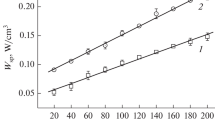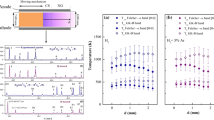Abstract
The hydrogen dissociation degree is measured by means of optical emission spectroscopy in the cathode sheath of cylindrical abnormal Grimm-type DC glow discharge operating in the hydrogen–argon mixture at low pressure. The degree of dissociation, ranging from 80% in the close vicinity of the cathode and decreasing to 60% towards the negative glow, is obtained from the intensity ratio of the hydrogen Balmer Hγ line and the diagonal Fulcher-α molecular bands. The cathode sheath thickness is extracted from the electric field strength distribution measured using Stark spectroscopy of the hydrogen Balmer Hα line. An electron temperature of 2.7 eV in the negative glow region is estimated by observing the intensity ratio of the diagonal Fulcher-α bands and the Hα line.
Graphical Abstract







Similar content being viewed by others
Data Availability Statement
This manuscript has no associated data or the data will not be deposited. [Authors' comment: The datasets supporting the conclusions of this article are available from the corresponding author upon reasonable request.]
References
A. von Engel, Ionized Gases (Oxford Clarendon Press, Oxford, 1965)
B. Chapman, Glow Discharge Processes: Sputtering and Plasma Etching (Wiley, New York, 1980)
R.K. Marcus, J.A. Broeckaert, Glow Discharge Plasmas in Analytical Spectroscopy (Wiley, Chichester, 2003)
P.F. Little, A. von Engel, The hollow-cathode effect and the theory of glow discharges. Proc. R. Soc. Lond. A 224, 209–227 (1954). https://doi.org/10.1098/rspa.1954.0152
R.S. Pessoa, L.L. Tezani, H.S. Maciel, G. Petraconi, M. Massi, Study of SF6 and SF6/O2 plasmas in a hollow cathode reactive ion etching reactor using Langmuir probe and optical emission spectroscopy techniques. Plasma Sources Sci. Technol. 19, 025013–025016 (2010). https://doi.org/10.1088/0963-0252/19/2/025013
M. Bacal, M. Wada, Negative hydrogen ion production mechanisms. Appl. Phys. Rev. 2, 021305 (2015). https://doi.org/10.1063/1.4921298
M.M. Vasiljević, G.L. Majstorović, Dj. Spasojević, N. Konjević, Q-branch of Fulcher-α diagonal bands for determination of the axial temperature distribution in the cathode sheath region of hydrogen and hydrogen-argon abnormal glow discharge. J. Quant. Spectrosc. Ra. 254, 107195 (2020). https://doi.org/10.1016/j.jqsrt.2020.107195
D. Spasojević, N.V. Ivanović, N.V. Nedić, M. Vasiljević, N.M. Šišović, N. Konjević, Iterative kinetic model application in diagnostics of argon abnormal DC glow discharges. Eur. Phys. J. D 77, 75 (2023). https://doi.org/10.1140/epjd/s10053-023-00650-4
U. Fantz, H. Falter, P. Franzen, D. Wunderlich, M. Berger, A. Lorenz, W. Kraus, P. McNeely, R. Riedl, E. Speth, Spectroscopy–a powerful diagnostic tool in source development. Nucl. Fusion 46, S297 (2006). https://doi.org/10.1088/0029-5515/46/6/S10
J.J. Dang, K.-J. Chung, Y.S. Hwang, A simple spectroscopic method to determine the degree of dissociation in hydrogen plasmas with wide-range spectrometer. Rev. Sci. Instrum. 87, 053503 (2016). https://doi.org/10.1063/1.4948919
I.R. Videnović, N. Konjević, M.M. Kuraica, Spectroscopic investigations of a cathode fall region of the Grimm-type glow discharge. Spectrochim. Acta B 51, 1707–1731 (1996). https://doi.org/10.1016/S0584-8547(96)01533-9
G.L. Majstorović, N.V. Ivanović, N.M. Šišović, S. Djurović, N. Konjević, Ar I and Ne I spectral line shapes for an abnormal glow discharge diagnostics. Plasma Sources Sci. Technol. 22, 045015 (2013). https://doi.org/10.1088/0963-0252/22/4/045015
W. Grimm, Glimmentladungslampe für spektralanalytische Routinemessungen. Naturwissenschaften 54, 586 (1967). https://doi.org/10.1007/BF00636820
W. Grimm, Eine neue Glimmentladungslampe für die optische Emissionsspektralanalyse. Spectrochim. Acta B 23, 443–454 (1968). https://doi.org/10.1016/0584-8547(68)80023-0
N.P. Ferreira, H.G.C. Human, L.R.P. Butler, Kinetic temperatures and electron densities in the plasma of a side view Grimm-type glow discharge. Spectrochim. Acta B 35, 285–295 (1980). https://doi.org/10.1016/0584-8547(80)80092-9
N.V. Ivanović, N.M. Šišović, Dj. Spasojević, N. Konjević, Measurement of the DC Stark shift for visible Ne I lines and electric field distribution in the cathode sheath of an abnormal glow discharge. J. Phys. D Appl. Phys. 50, 125201–125216 (2017). https://doi.org/10.1088/1361-6463/aa5c1f
D. Spasojević, S. Mijin, N.M. Šišović, N. Konjević, Spectroscopic application of an iterative kinetic cathode sheath model to high voltage hollow cathode glow discharge in hydrogen. J. Appl. Phys. 119, 053301 (2016). https://doi.org/10.1063/1.4941267
D. Spasojević, V. Steflekova, N.M. Šišović, N. Konjević, Spectroscopic application of an iterative kinetic model of the cathode-fall region in a hydrogen abnormal glow discharge. Plasma Sources Sci. Technol. 23, 012004 (2014). https://doi.org/10.1088/0963-0252/23/1/012004
D. Spasojević, N.V. Ivanović, N.V. Nedić, N.M. Šišović, N. Konjević, Complex UV Ne II line shapes in the cathode sheath of an abnormal glow discharge. Plasma Sources Sci. Technol. 29, 085008 (2020). https://doi.org/10.1088/1361-6595/aba48a
W.H. Press, S.A. Teukolsky, W.T. Vetterling, B.P. Flannery, Numerical Recipes: The Art of Scientific Computing, 3rd edn. (Cambridge University Press, Cambridge, 2007)
T.E. Sharp, Potential-energy curves for molecular hydrogen and its ions. Atom. Data Nucl. Data 2, 119–169 (1970). https://doi.org/10.1016/S0092-640X(70)80007-9
H.M. Crosswhite, The Hydrogen Molecule Wavelength Tables of Gerhard Heinrich Dieke (Wiley-Interscience, New York, 1972)
G. Herzberg, Molecular Spectra and Molecular Structure, Spectra of Diatomic Molecules, vol. 1 (Krieger Publishing Co, Malabar FL, 1989)
I. Kovacs, Rotational Structure in the Spectra of Diatomic Molecules (Adam Hilger LTD, London, 1969)
S.A. Astashkevich, M. Käning, E. Käning, N.V. Kokina, B.P. Lavrov, A. Ohl, J. Röpcke, Radiative characteristics of 3p Σ, Π; 3d Π-, Δ- states of H2 and determination of gas temperature of low pressure hydrogen containing plasmas. J. Quant. Spectrosc. Ra. 56, 725–751 (1996). https://doi.org/10.1016/S0022-4073(96)00103-3
U. Fantz, D. Wünderlich, Franck-condons factors, transition probabilities and radiative lifetimes for hydrogen molecules and their isotopomeres, INDC(NDS)-457 (2004)
J. Geddes, R.W. McCullough, A. Donnelly, H.B. Gilbody, Dissociation of hydrogen in high-frequency discharges. Plasma Sources Sci. Technol. 2, 93 (1993). https://doi.org/10.1088/0963-0252/2/2/004
R.F.G. Meulenbroeks, A.J. van Beek, A.J.G. van Helvoort, M.C.M. van de Sanden, D.C. Schram, Argon-hydrogen plasma jet investigated by active and passive spectroscopic means. Phys. Rev. E 49, 4397 (1994). https://doi.org/10.1103/PhysRevE.49.4397
A. Bogaerts, R. Gijbels, Effects of adding hydrogen to an argon glow discharge: overview of relevant processes and some qualitative explanations. J. Anal. At. Spectrom. 15, 441–449 (2000). https://doi.org/10.1039/A909779A
M. Capitelli, M. Dilonardo, Nonequilibrium vibrational populations of diatomic species in electrical discharges: effects of the dissociation rates. Chem. Phys. 24, 417–427 (1977). https://doi.org/10.1016/0301-0104(77)85102-1
B.P. Lavrov, N. Lang, A.V. Pipa, J. Röpcke, On determination of the degree of dissociation of hydrogen in non-equilibrium plasmas by means of emission spectroscopy: II. Experimental verification. Plasma Sources Sci. Technol. 15, 147 (2006). https://doi.org/10.1088/0963-0252/15/1/021
A. Bogaerts, A. Quentmeier, N. Jakubowski, R. Gijbels, Plasma diagnostics of an analytical Grimm-type glow discharge in argon and in neon: langmuir probe and optical emission spectrometry measurements. Spectrochim. Acta B 50, 1337 (1995)
Z. Weiss, Emission spectroscopic diagnostics of weakly ionized argon-diluted plasmas: glow discharge and inductively coupled plasma. Plasma Sources Sci. Technol. 29, 105018 (2020). https://doi.org/10.1088/1361-6595/abb41e
K. Kondo, K. Okazaki, H. Oyama, T. Oda, Y. Sakamoto, A. Iiyoshi, Electron temperature measurement using Fulcher-α (d3Πu–a3Σg) to Hα emissions in a weekly ionized plasma. Jap. J. Appl. Phys. 27, 1560 (1988). https://doi.org/10.1143/JJAP.27.1560
G.R. Möhlmann, F.J. de Heer, Emission cross sections of the H2(3p3Πu→2s3Σ+g) transition for electron impact on H2. Chem. Phys. Lett. 43, 240–244 (1976). https://doi.org/10.1016/0009-2614(76)85294-3
G.R. Möhlmann, F.J. de Heer, J. Los, Emission cross sections of Balmer-α, β, γ radiation for electrons (0–2000 eV) on H2 and D2. Chem. Phys. 25, 103–116 (1977). https://doi.org/10.1016/0301-0104(77)87067-5
Acknowledgements
This work is supported by the Ministry of Science, Technological Development and Innovations of the Republic of Serbia (Grant No. 451-03-47/2023-01/200162). Part of the results was presented at the 31st Summer School and International Symposium on the Physics of Ionized Gasses (SPIG), September 5–9, 2022, Belgrade, Serbia. Conference proceedings: https://publications.aob.rs/102/pdf/spig2022-23-8.pdf.
Author information
Authors and Affiliations
Contributions
MMV contributed to conceptualization, methodology, investigation, and writing. GLM contributed to conceptualization, methodology, investigation, and writing. IRV contributed to conceptualization, methodology, and writing—review. DS contributed to conceptualization, methodology, and supervision.
Corresponding author
Ethics declarations
Conflict of interest
The authors declare that they have no known competing financial interests or personal relationships that could have appeared to influence the work reported in this paper.
Rights and permissions
Springer Nature or its licensor (e.g. a society or other partner) holds exclusive rights to this article under a publishing agreement with the author(s) or other rightsholder(s); author self-archiving of the accepted manuscript version of this article is solely governed by the terms of such publishing agreement and applicable law.
About this article
Cite this article
Vasiljević, M.M., Majstorović, G.L., Videnović, I.R. et al. Hydrogen dissociation degree in the Grimm-type glow discharge measured by optical emission spectroscopy. Eur. Phys. J. D 77, 130 (2023). https://doi.org/10.1140/epjd/s10053-023-00704-7
Received:
Accepted:
Published:
DOI: https://doi.org/10.1140/epjd/s10053-023-00704-7




